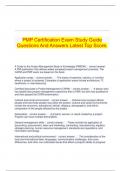PMP Certification Exam Study Guide
Questions And Answers Latest Top Score.
A Guide to the Project Management Body of Knowledge (PMBOK) - correct answer.
A PMI publication that defines widely accepted project management practices. The
CAPM and PMP exam are based on this book.
Application areas - correct answer. The areas of expertise, industry, or function
where a project is centered. Examples of application areas include architecture, IT,
healthcare, or manufacturing.
Certified Associate in Project Management (CAPM) - correct answer. A person who
has slightly less project management experience than a PMP, but who has qualified for
and then passed the CAPM examination.
Cultural and social environment - correct answer. Defines how a project affects
people and how those people may affect the project. Cultural and social environments
include the economic, educational, ethical, religious, demographic, and ethnic
composition of the people affected by the project.
Deliverable - correct answer. A product, service, or result created by a project.
Projects can have multiple deliverables.
General management skills - correct answer. These include the application of
accounting, procurement, sales and marketing, contracting, manufacturing, logistics,
strategic planning, human resource management, standards and regulations, and
information technology.
International and political environment - correct answer. The consideration of the
local and international laws, languages, communication challenges, time zone
differences, and other non-collocated issues that affect a project's ability to progress.
,Interpersonal skills - correct answer. The ability to interact, lead, motivate, and
manage people.
Iron Triangle of Project Management - correct answer. A triangle with the
characteristics of time, cost, and scope. Time, cost, and scope each constitute one side
of the triangle; if any side of the Iron Triangle is not in balance with the other sides, the
project will suffer. The Iron Triangle of Project Management is also known as the Triple
Constraints of Project Management, as all projects are constrained by time, cost, and
scope.
Physical environment - correct answer. The physical structure and surroundings that
affect a project's work.
Program - correct answer. A collection of related projects working in unison toward a
common deliverable.
Progressive elaboration - correct answer. The process of gathering project details in
steady, uniform steps. This process uses deductive reasoning, logic, and a series of
information-gathering techniques to identify details about a project, product, or solution.
Project - correct answer. A short-term endeavor to create a unique product, service,
or result. The end result of a project is also called a deliverable.
Project environment - correct answer. The location and culture of the environment
where the project work will reside. The project environment includes the social,
economic, and environmental variables the project must work with or around.
Project Management Institute (PMI) - correct answer. An organization of project
management professionals from around the world, supporting and promoting the
careers, values, and concerns of project managers.
Project management office (PMO) - correct answer. A central office that oversees all
projects within an organization or within a functional department. A PMO supports the
project management through software, training, templates, policies, communication,
dispute resolution, and other services.
Project Management Professional (PMP) - correct answer. A person who has
proven project management experience and has qualified for and then passed the PMP
certification examination.
Project portfolio management - correct answer. The management and selection of
projects, that support an organization's vision and mission. It is the balance of project
priority, risk, reward, and return on investment. This is a senior management process.
, Subprojects - correct answer. A smaller project managed within a larger, parent
project. Subprojects are often contracted work whose deliverable allows the larger
project to progress.
Triple Constraints of Project Management - correct answer. Also known as the Iron
Triangle. This theory posits that time, cost, and scope are three constraints that every
project has.
A series of activities to create a unique product or service by a specific date is best
described as which one of the following?
A. A program
B. An operation
C. A project
D. A subproject - correct answer. C. A project is a temporary endeavor to create a
unique product, service, or result. Deadlines and cost constraints are tied to the project.
A is incorrect because programs are a collection of projects working toward a common
cause. B is incorrect because operations are ongoing activities of an organization. D, a
subproject, describes a project that is part of and supports a larger project.
Which of the following is likely to be part of an operation?
A. Providing electricity to a community
B. Designing an electrical grid for a new community
C. Building a new dam as a source of electricity
D. Informing the public about changes at the electrical company. - correct answer.
A. Providing electricity to a community is the best example of operations, as it is an
ongoing activity. B, C, and D are all examples of projects, as they are temporary and
create a unique product, service, or result.
Of the following, which one is the best examples of progressive elaboration?
A. It is the process of decomposing the work into small, manageable, tasks.
B. It is the process of taking a project from concept to completion.
C. It is the process of taking a project concept to a project budget.
D. It is the process of identifying the business needs of a potential project. - correct
answer. B. According to the PMBOK, progressive elaboration means developing in
steps and then continuing by increments. Choice A describes the process of breaking
down the project scope into the task list. C is not a valid choice for this question. D is
part of determining if a project should be chartered and is not the best answer for this
question.
Your organization would like to create a new product based on market research. This
new product will be created by a project. This is an example of which one of the
following reasons to launch a new project?
A. Organizational need
B. Customer request
C. Market demand




